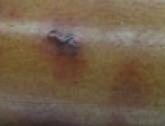We report the case of a 61-year-old man with diffuse large B-cell lymphoma who presented with a tender skin lesion on the left side of the flank of 5 weeks’ duration after undergoing myeloablative chemotherapy. Prior treatment with intravenous vancomycin showed minimal response. Clinical examination revealed a tender, indurated, erythematous plaque on the left side of the flank. A skin biopsy demonstrated a lymphohistiocytic and neutrophilic infiltrate with deep dermal necrosis and fungal forms in the dermis and subcutis. A tissue culture grew Candida tropicalis; however, blood cultures remained negative for yeast. A diagnosis of primary cutaneous candidiasis was made based on the lack of response to antibiotics, tissue evidence of C tropicalis, and negative blood cultures. Although rare, primary cutaneous candidiasis should be considered in immunocompromised patients presenting with cellulitis or an abscess that is unresponsive to treatment.


